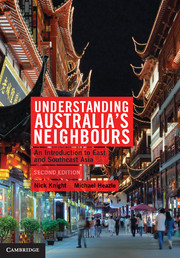Book contents
- Frontmatter
- Contents
- List of Maps
- Acronyms and abbreviations
- Acknowledgments
- Maps
- Introduction
- 1 The idea of ‘Asia’
- 2 Tradition and modernity in East and Southeast Asia
- 3 Tradition and modernity in East and Southeast Asia
- 4 Colonialism in East and Southeast Asia
- 5 Nationalism and revolution in East and Southeast Asia
- 6 Nations and nation-building in East and Southeast Asia
- 7 International politics and East and Southeast Asia
- 8 Economic growth in East and Southeast Asia
- 9 Democracy, human rights and development
- 10 Globalisation and East and Southeast Asia
- 11 China–Japan relations and US power in the twenty-first century
- 12 Australia in Asia, ‘Asia’ in Australia
- Bibliography
- Index
- References
1 - The idea of ‘Asia’
Australia's ‘Near North’ – East and Southeast Asia
Published online by Cambridge University Press: 05 June 2012
- Frontmatter
- Contents
- List of Maps
- Acronyms and abbreviations
- Acknowledgments
- Maps
- Introduction
- 1 The idea of ‘Asia’
- 2 Tradition and modernity in East and Southeast Asia
- 3 Tradition and modernity in East and Southeast Asia
- 4 Colonialism in East and Southeast Asia
- 5 Nationalism and revolution in East and Southeast Asia
- 6 Nations and nation-building in East and Southeast Asia
- 7 International politics and East and Southeast Asia
- 8 Economic growth in East and Southeast Asia
- 9 Democracy, human rights and development
- 10 Globalisation and East and Southeast Asia
- 11 China–Japan relations and US power in the twenty-first century
- 12 Australia in Asia, ‘Asia’ in Australia
- Bibliography
- Index
- References
Summary
DEFINING ‘THE REGION’
BEFORE WE BEGIN to study something called ‘Asia’ we have to decide what it is we are studying. We have to decide what we include and what we exclude; we need to explain and justify our definition of ‘Asia’. This is important because, conceived extensively, Asia can be defined as all of the land mass on the continent of Asia east of the Mediterranean Sea, plus the islands of Japan and Southeast Asia. Map 1 provides a visual representation of this very extensive idea of Asia. We would face a difficult task if we employed this definition of Asia, as we would have to cover the following regions:
Asia (or the sub-continent of Asia – India, West and Southwest Asia (often called the Middle East – Turkey, Israel, Lebanon, Jordan, Syria, Iraq, Iran, Saudi Arabia, and other countries)
South Pakistan, Nepal, Bangladesh, Sri Lanka)
Northern and Central Asia (Russia, the Central Asian states such as Turkmenistan, Uzbekistan, Kazakhstan, Kyrgyzstan and so on)
East Asia (China, Japan, North and South Korea. See Map 3.)
Southeast Asia (mainland Southeast Asia – Vietnam, Cambodia, Laos, Thailand, Myanmar [Burma], Malaysia; and island Southeast Asia – parts of Malaysia, Singapore, Indonesia, Brunei, the Philippines, and East Timor. See Map 4.)
The reader can see at a glance that if we attempted to cover such a huge geographical area, we could only do it very superficially. Rather than attempting this, we will make a judgment about what we mean by the term ‘Asia’, one that will define our field of study and limit it to more manageable proportions. It is possible to make this sort of judgment as the concept of ‘Asia’ is not a fixed one, and its meaning and significance are not universally agreed. ‘Asia’ is a construction, invented and used by human beings to describe something they think exists in reality. For our own convenience, and for reasons relating to the Australian perspective adopted in this book, the construction of ‘Asia’ we will use will be limited to the region occupied by those countries in the last two dot points listed above, and visually represented in Maps 2, 3 and 4.
- Type
- Chapter
- Information
- Understanding Australia's NeighboursAn Introduction to East and Southeast Asia, pp. 5 - 22Publisher: Cambridge University PressPrint publication year: 2011



